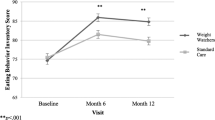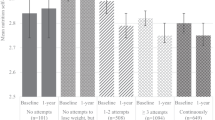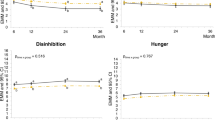Abstract
Objective:
Compare the Healthy Weight obesity and eating disorder prevention program, which promotes participant-driven gradual lifestyle changes to bring energy intake and expenditure into balance, to a new intervention, Project Health, which adds activities to create cognitive dissonance about unhealthy eating, a sedentary lifestyle, and excess body fat, and an obesity education video-control condition.
Method:
College students at risk for both outcomes because of weight concerns (N=364, 72% female) were randomized to condition, completing pretest, posttest, and 6, 12 and 24-month follow-up assessments.
Results:
Project Health participants showed significantly smaller increases in measured body mass index (BMI) through 2-year follow-up than both Healthy Weight participants and controls (both d=−0.18), and significantly lower onset of overweight/obesity over 2-year follow-up than Healthy Weight participants and controls (13 vs 21% and 22%). Healthy Weight and Project Health participants showed significantly greater eating disorder symptom reductions than controls through 2-year follow-up. Healthy Weight and Project Health participants showed marginally lower eating disorder onset over follow-up than controls (3 and 3% vs 8% respectively).
Conclusions:
The reduced increases in BMI and future overweight/obesity onset for Project Health relative to both an active matched intervention and a minimal intervention control condition are noteworthy, especially given the short 6-h intervention duration. The reduction in eating disorder symptoms for Healthy Weight and Project Health relative to controls was also encouraging. Results suggest that adding dissonance-induction activities increased weight loss effects. Yet, effects for both were generally small and the eating disorder onset prevention effects were only marginal, potentially because intervention groups included both sexes, which reduced eating disorder incidence and sensitivity.
This is a preview of subscription content, access via your institution
Access options
Subscribe to this journal
Receive 12 print issues and online access
$259.00 per year
only $21.58 per issue
Buy this article
- Purchase on Springer Link
- Instant access to full article PDF
Prices may be subject to local taxes which are calculated during checkout


Similar content being viewed by others
References
Flegal KM, Carroll MD, Kit BK, Ogden CL . Prevalence of obesity and trends in the distribution of body mass index among US adults, 1999-2010. JAMA 2012; 307: 491.
Swanson Sa, Crow SJ, Le Grange D, Swendsen J, Merikangas KR . Prevalence and correlates of eating disorders in adolescents. Results from the national comorbidity survey replication adolescent supplement. Arch Gen Psychiatry 2011; 68: 714–723.
Stice E, Marti CN, Spoor S, Presnell K, Shaw H . Dissonance and healthy weight eating disorder prevention programs: Long-term effects from a randomized efficacy trial. J Consult Clin Psychol 2008; 76: 329–340.
Stice E, Shaw H, Burton E, Wade E . Dissonance and healthy weight eating disorder prevention programs: A randomized efficacy trial. J Consult Clin Psychol 2006; 74: 263–275.
Stice E, Rohde P, Shaw H, Marti CN . Efficacy trial of a selective prevention program targeting both eating disorder symptoms and unhealthy weight gain among female college students. J Consult Clin Psychol 2012; 80: 164–170.
Stice E, Rohde P, Shaw H, Marti CN . Efficacy trial of a selective prevention program targeting both eating disorders and obesity among female college students: 1- and 2-year follow-up effects. J Consult Clin Psychol 2013; 81: 183–189.
Stice E, Yokum S, Burger K, Rohde P, Shaw H, Gau JM . A pilot randomized trial of a cognitive reappraisal obesity prevention program. Physiol Behav 2015; 138: 124–132.
Becker CB, Smith LM, Ciao AC . Reducing eating disorder risk factors in sorority members: A randomized trial. Behav Ther 2005; 36: 245–253.
Halliwell E, Diedrichs PC . Testing a dissonance body image intervention among young girls. Heal Psychol 2014; 33: 201–204.
Mitchell KS, Mazzeo SE, Rausch SM, Cooke KL . Innovative interventions for disordered eating: Evaluating dissonance-based and yoga interventions. Int J Eat Disord 2007; 40: 120–128.
Festinger L . A Theory of Cognitive Dissonance. Stanford University Press: Stanford, CA, USA, 1957.
Green M, Scott N, Diyankova I, Gasser C . Eating disorder prevention: an experimental comparison of high level dissonance, low level dissonance, and no-treatment control. Eat Disord 2005; 13: 157–169.
McMillan W, Stice E, Rohde P . High- and low-level dissonance-based eating disorder prevention programs with young women with body image concerns: An experimental trial. J Consult Clin Psychol 2011; 79: 129–134.
Stice E, Yokum S, Waters A . Dissonance-based eating disorder prevention program reduces reward region response to thin models; how actions shape valuation. PLoS One 2015; 10: e0144530.
Allen KL, Byrne SM, Oddy WH, Crosby RD . DSM–IV–TR and DSM-5 eating disorders in adolescents: Prevalence, stability, and psychosocial correlates in a population-based sample of male and female adolescents. J Abnorm Psychol 2013; 122: 720–732.
Stice E, Gau J, Rohde P, Shaw H . Risk factors that predict future onset of each DSM-5 eating disorder: Predictive specificity in high-risk adolescent females. J Abnorm Psychol 2017; 126: 38–51.
Pietrobelli A, Faith MS, Allison DB, Gallagher D, Chiumello G, Heymsfield SB . Body mass index as a measure of adiposity among children and adolescents: A validation study. J Pediatr 1998; 132: 204–210.
Graham JW . Missing data analysis: making it work in the real world. Annu Rev Psychol 2009; 60: 549–576.
Raghunathan TE, Solenberger PW, Van Hoewyk J . IVEware: Imputation and variance estimation software. Institute for Social Research, University of Michigan: Ann Arbor, MI, USA, 2002.
Rubin DB . Multiple Imputation for Nonresponse in Sruveys. John Wiley & Sons, Inc: New York, NY, USA, 1987.
Baldwin SA, Bauer DJ, Stice E, Rohde P . Evaluating models for partially clustered designs. Psychol Methods 2011; 16: 149–165.
Feingold A . Effect sizes for growth-modeling analysis for controlled clinical trials in the same metric as for classical analysis. Psychol Methods 2009; 14: 43–53.
StataCorp Stata Statistical Software. StataCorp LP: College Station, TX, USA, 2007.
Collaboration. Estimating the reproducibility of psychological science. Science (80-) 2015; 349: aac4716.
Stice E, Marti CN, Shaw H, Jaconis M . An 8-year longitudinal study of the natural history of threshold, subthreshold, and partial eating disorders from a community sample of adolescents. J Abnorm Psychol 2009; 118: 587–597.
Stice E, Shaw H, Marti CN . A meta-analytic review of obesity prevention programs for children and adolescents: The skinny on interventions that work. Psychol Bull 2006; 132: 667–691.
Gow RW, Trace SE, Mazzeo SE . Preventing weight gain in first year college students: An online intervention to prevent the “freshman fifteen.”. Eat Behav 2010; 11: 33–39.
Plotnikoff RC, Costigan SA, Williams RL, Hutchesson MJ, Kennedy SG, Robards SL et al. Effectiveness of interventions targeting physical activity, nutrition and healthy weight for university and college students: a systematic review and meta-analysis. Int J Behav Nutr Phys Act 2015; 12: 45.
Corbin WR, McNair LD, Carter JA . Evaluation of a treatment-appropriate cognitive intervention for challenging alcohol outcome expectancies. Addict Behav 2001; 26: 475–488.
Wiers RW, Kummeling RHC . An experimental test of an alcohol expectancy challenge in mixed gender groups of young heavy drinkers. Addict Behav 2004; 29: 215–220.
Neumark-Sztainer D . Preventing obesity and eating disorders in adolescents: what can health care providers do? J Adolesc Heal 2009; 44: 206–213.
O’Dea JA . Prevention of child obesity: ‘First, do no harm’. Health Educ Res 2005; 20: 259–265.
The Condition of Education The Condition of Education. US Department of Education: Washington, DC, USA, 2008.
Acknowledgements
This study was supported by grant (HD071900) from the National Institutes of Health. We thank project research assistants Juliana Bednarski, Shelley Durant, Julie Pope, and Victoria Perko, as well as the undergraduates who volunteered to participate in this trial. ClinicalTrials.gov Identifier: NCT01680224.
Author information
Authors and Affiliations
Corresponding author
Ethics declarations
Competing interests
The authors declare no conflict of interest.
Additional information
The first 61 participants assigned to the Healthy Weight condition and the first 62 participants assigned to the educational video condition from the present trial were included in a preliminary evaluation of the Minding Health obesity prevention program, which focuses on cognitive reappraisal techniques. It should also be noted that due to a malfunction in the Bod Pod, we were not able to collect valid body fat data for all participants in the present trial, which was an outcome in the preliminary evaluation of Minding Health.
Rights and permissions
About this article
Cite this article
Stice, E., Rohde, P., Shaw, H. et al. An experimental therapeutics test of whether adding dissonance-induction activities improves the effectiveness of a selective obesity and eating disorder prevention program. Int J Obes 42, 462–468 (2018). https://doi.org/10.1038/ijo.2017.251
Received:
Revised:
Accepted:
Published:
Issue Date:
DOI: https://doi.org/10.1038/ijo.2017.251
This article is cited by
-
Body dissatisfaction and disordered eating in the perinatal period: an underrecognized high-risk timeframe and the opportunity to intervene
Archives of Women's Mental Health (2022)
-
Prevention of high body mass index and eating disorders: a systematic review and meta-analysis
Eating and Weight Disorders - Studies on Anorexia, Bulimia and Obesity (2022)
-
Integrating eating disorder and weight gain prevention: a pilot and feasibility trial of INSPIRE
Eating and Weight Disorders - Studies on Anorexia, Bulimia and Obesity (2020)
-
Prevention of eating disorders: current evidence-base for dissonance-based programmes and future directions
Eating and Weight Disorders - Studies on Anorexia, Bulimia and Obesity (2019)



